Data Structures and Algorithms
- Introduction to Data Structures and Algorithms
- Time and Space Complexity Analysis
- Big-O, Big-Theta, and Big-Omega Notations
- Recursion and Backtracking
- Divide and Conquer Algorithm
- Dynamic Programming: Memoization vs. Tabulation
- Greedy Algorithms and Their Use Cases
- Understanding Arrays: Types and Operations
- Linear Search vs. Binary Search
- Sorting Algorithms: Bubble, Insertion, Selection, and Merge Sort
- QuickSort: Explanation and Implementation
- Heap Sort and Its Applications
- Counting Sort, Radix Sort, and Bucket Sort
- Hashing Techniques: Hash Tables and Collisions
- Open Addressing vs. Separate Chaining in Hashing
- DSA Questions for Beginners
- Advanced DSA Questions for Competitive Programming
- Top 10 DSA Questions to Crack Your Next Coding Test
- Top 50 DSA Questions Every Programmer Should Practice
- Top Atlassian DSA Interview Questions
- Top Amazon DSA Interview Questions
- Top Microsoft DSA Interview Questions
- Top Meta (Facebook) DSA Interview Questions
- Netflix DSA Interview Questions and Preparation Guide
- Top 20 DSA Interview Questions You Need to Know
- Top Uber DSA Interview Questions and Solutions
- Google DSA Interview Questions and How to Prepare
- Airbnb DSA Interview Questions and How to Solve Them
- Mobile App DSA Interview Questions and Solutions
DSA Interview Questions
- DSA Questions for Beginners
- Advanced DSA Questions for Competitive Programming
- Top 10 DSA Questions to Crack Your Next Coding Test
- Top 50 DSA Questions Every Programmer Should Practice
- Top Atlassian DSA Interview Questions
- Top Amazon DSA Interview Questions
- Top Microsoft DSA Interview Questions
- Top Meta (Facebook) DSA Interview Questions
- Netflix DSA Interview Questions and Preparation Guide
- Top 20 DSA Interview Questions You Need to Know
- Top Uber DSA Interview Questions and Solutions
- Google DSA Interview Questions and How to Prepare
- Airbnb DSA Interview Questions and How to Solve Them
- Mobile App DSA Interview Questions and Solutions
Introduction to High-Level System Design
System Design Fundamentals
- Functional vs. Non-Functional Requirements
- Scalability, Availability, and Reliability
- Latency and Throughput Considerations
- Load Balancing Strategies
Architectural Patterns
- Monolithic vs. Microservices Architecture
- Layered Architecture
- Event-Driven Architecture
- Serverless Architecture
- Model-View-Controller (MVC) Pattern
- CQRS (Command Query Responsibility Segregation)
Scaling Strategies
- Vertical Scaling vs. Horizontal Scaling
- Sharding and Partitioning
- Data Replication and Consistency Models
- Load Balancing Strategies
- CDN and Edge Computing
Database Design in HLD
- SQL vs. NoSQL Databases
- CAP Theorem and its Impact on System Design
- Database Indexing and Query Optimization
- Database Sharding and Partitioning
- Replication Strategies
API Design and Communication
Caching Strategies
- Types of Caching
- Cache Invalidation Strategies
- Redis vs. Memcached
- Cache-Aside, Write-Through, and Write-Behind Strategies
Message Queues and Event-Driven Systems
- Kafka vs. RabbitMQ vs. SQS
- Pub-Sub vs. Point-to-Point Messaging
- Handling Asynchronous Workloads
- Eventual Consistency in Distributed Systems
Security in System Design
Observability and Monitoring
- Logging Strategies (ELK Stack, Prometheus, Grafana)
- API Security Best Practices
- Secure Data Storage and Access Control
- DDoS Protection and Rate Limiting
Real-World System Design Case Studies
- Distributed locking (Locking and its Types)
- Memory leaks and Out of memory issues
- HLD of YouTube
- HLD of WhatsApp
System Design Interview Questions
- Adobe System Design Interview Questions
- Top Atlassian System Design Interview Questions
- Top Amazon System Design Interview Questions
- Top Microsoft System Design Interview Questions
- Top Meta (Facebook) System Design Interview Questions
- Top Netflix System Design Interview Questions
- Top Uber System Design Interview Questions
- Top Google System Design Interview Questions
- Top Apple System Design Interview Questions
- Top Airbnb System Design Interview Questions
- Top 10 System Design Interview Questions
- Mobile App System Design Interview Questions
- Top 20 Stripe System Design Interview Questions
- Top Shopify System Design Interview Questions
- Top 20 System Design Interview Questions
- Top Advanced System Design Questions
- Most-Frequented System Design Questions in Big Tech Interviews
- What Interviewers Look for in System Design Questions
- Critical System Design Questions to Crack Any Tech Interview
- Top 20 API Design Questions for System Design Interviews
- Top 10 Steps to Create a System Design Portfolio for Developers
Kruskal’s Algorithm for Minimum Spanning Tree (MST)
Discover how Kruskal’s Algorithm constructs a Minimum Spanning Tree (MST) using a greedy strategy that ensures the lowest possible total weight. If you’re eager to enhance your algorithms expertise and receive free resources or stay updated on new courses, sign up here for our complimentary offerings and the latest updates tailored just for you.
Minimum Spanning Tree (MST)
A Minimum Spanning Tree (MST), also known as a minimum weight spanning tree, is a subset of the edges in a connected, undirected, and weighted graph that connects all vertices without forming any cycles and has the minimum possible total edge weight. In simple terms, it’s a tree that spans all the vertices of the graph while keeping the total weight as low as possible.
The weight of a spanning tree refers to the sum of the weights of all the edges included in that tree.
Understanding Kruskal’s Algorithm
Kruskal’s Algorithm is one of the most efficient methods to find the Minimum Spanning Tree in a graph. The algorithm follows a greedy approach, which means it builds the MST step by step by always choosing the lowest weight edge that does not form a cycle.
The process starts by sorting all edges in ascending order of weight. Then, it continues to add edges to the MST, one by one, as long as they do not result in a cycle. The algorithm prioritizes the edge with the smallest weight first and the largest weight last. This behavior of making the best local choice at each step helps in arriving at the globally optimal solution.
Because of this approach, Kruskal’s Algorithm is classified as a Greedy Algorithm.
How to Find the MST Using Kruskal’s Algorithm?
To construct a Minimum Spanning Tree using Kruskal’s Algorithm, follow these steps:
- Sort all edges in the graph in non-decreasing order based on their weights.
- Pick the smallest weight edge. Check whether adding this edge creates a cycle in the spanning tree formed so far.
- If it does not form a cycle, include the edge in the MST.
- If it forms a cycle, discard the edge.
- If it does not form a cycle, include the edge in the MST.
- Repeat step 2 until the spanning tree contains exactly (V – 1) edges, where V is the number of vertices in the graph.
To efficiently check for cycles during this process, Kruskal’s Algorithm uses the Disjoint Set Data Structure (also known as Union-Find). This helps keep track of the connected components and efficiently determines whether including a new edge will cause a cycle.
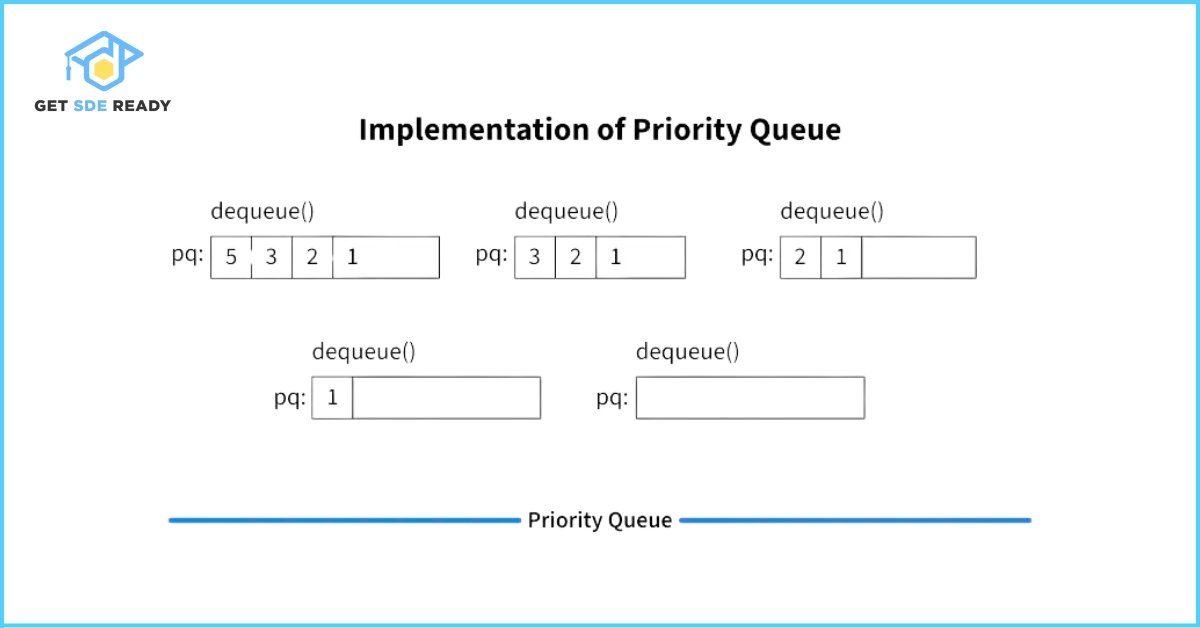

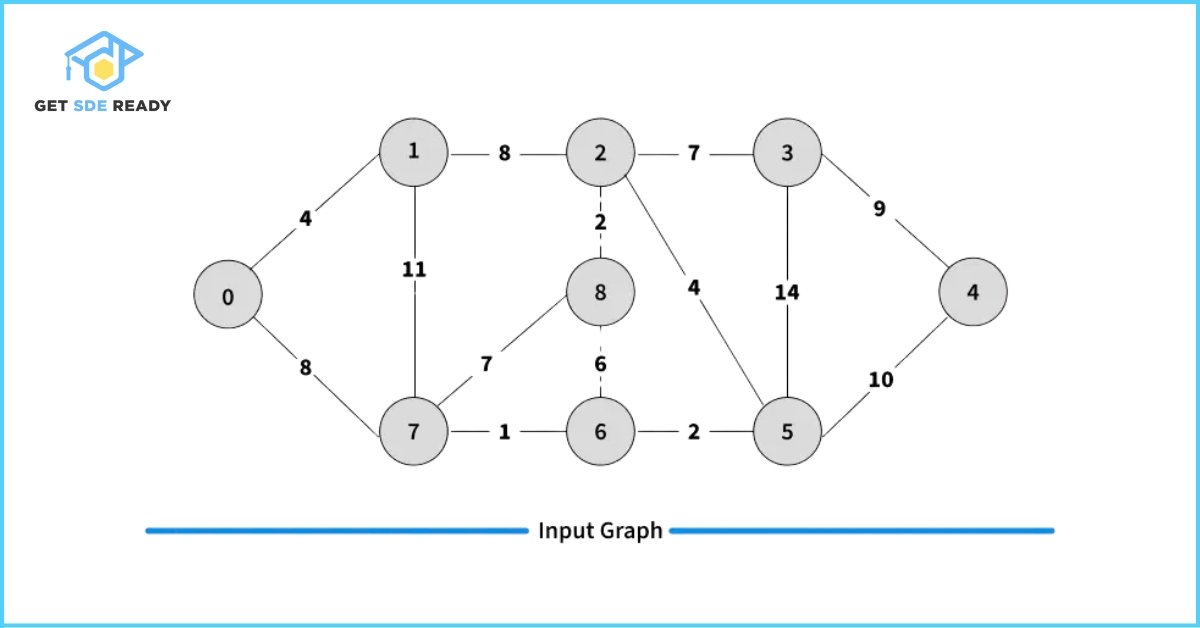
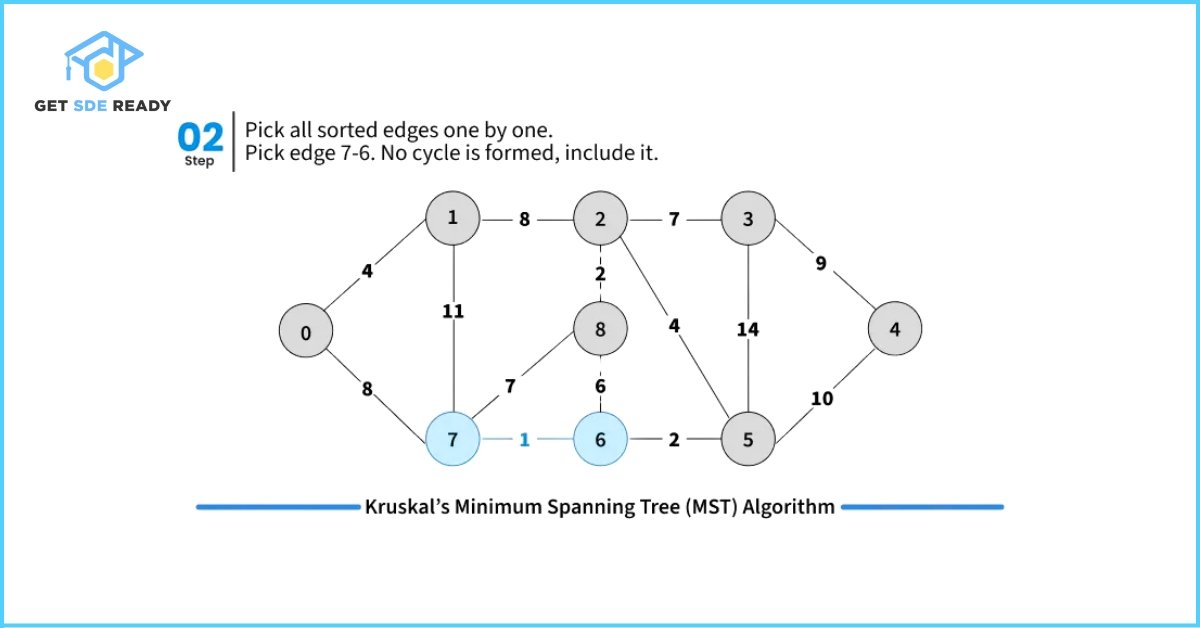
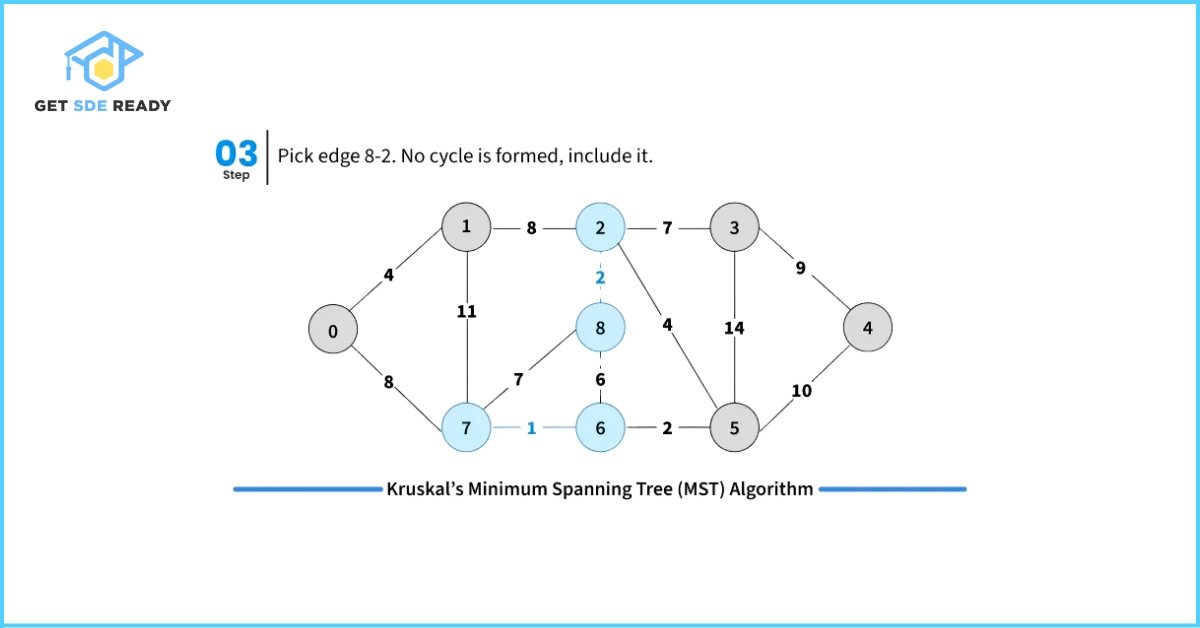
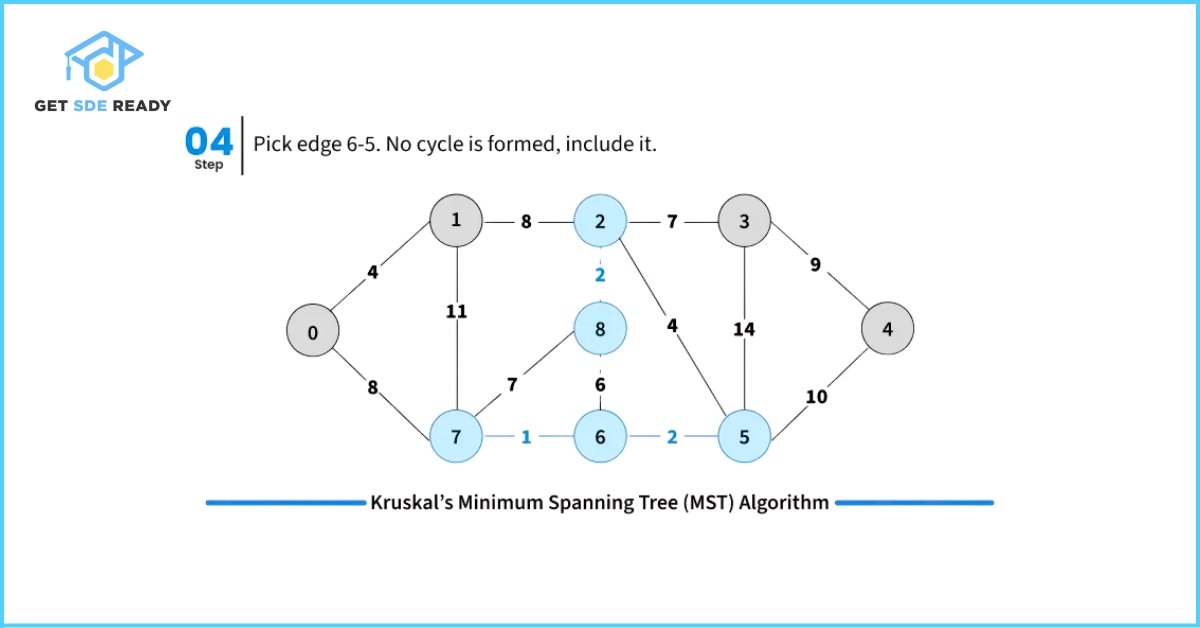
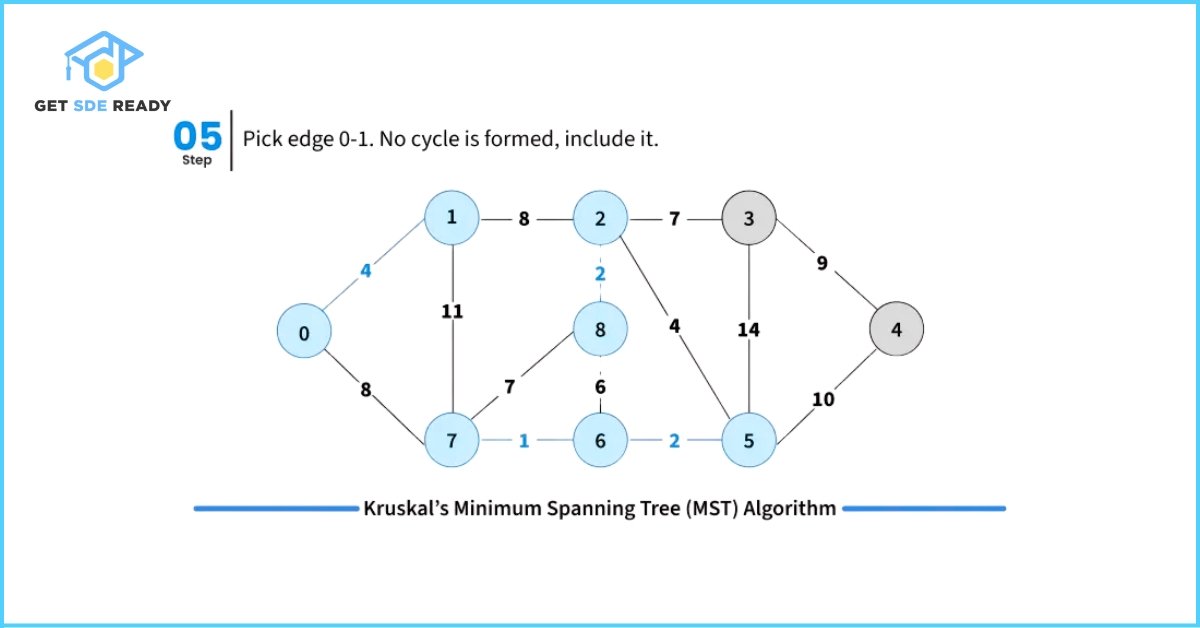
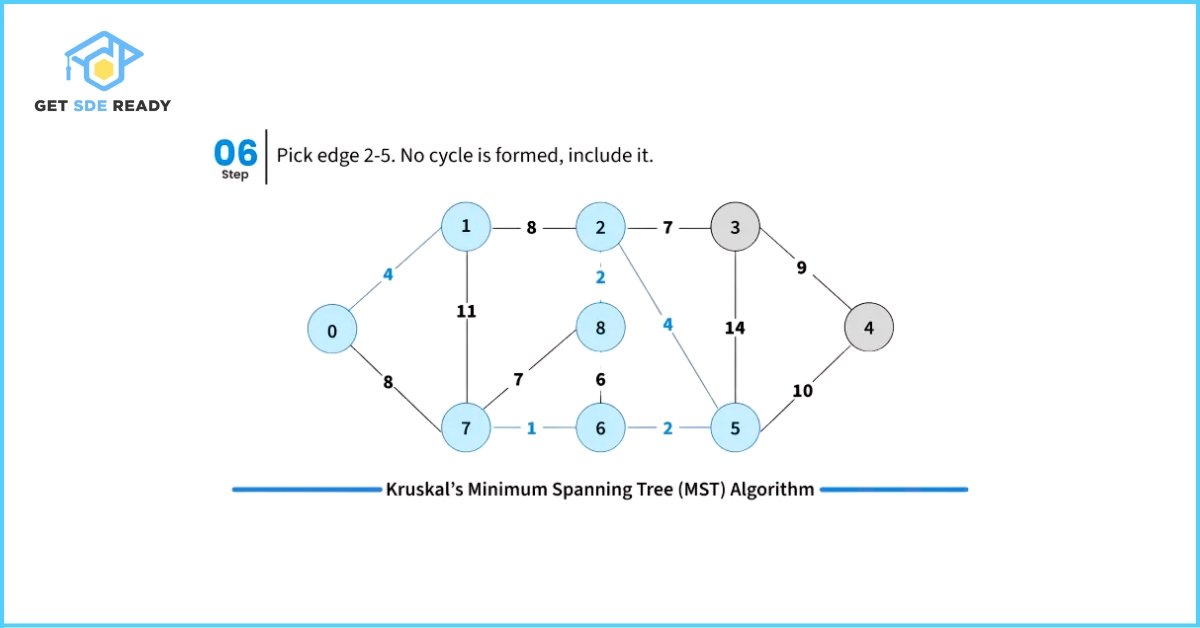
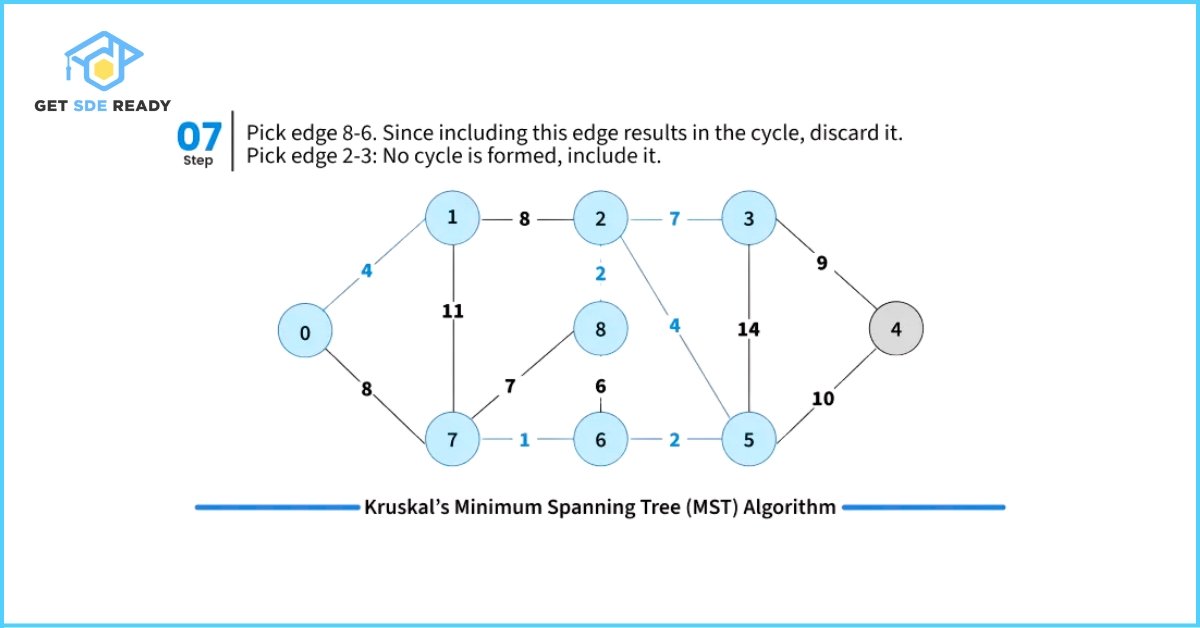
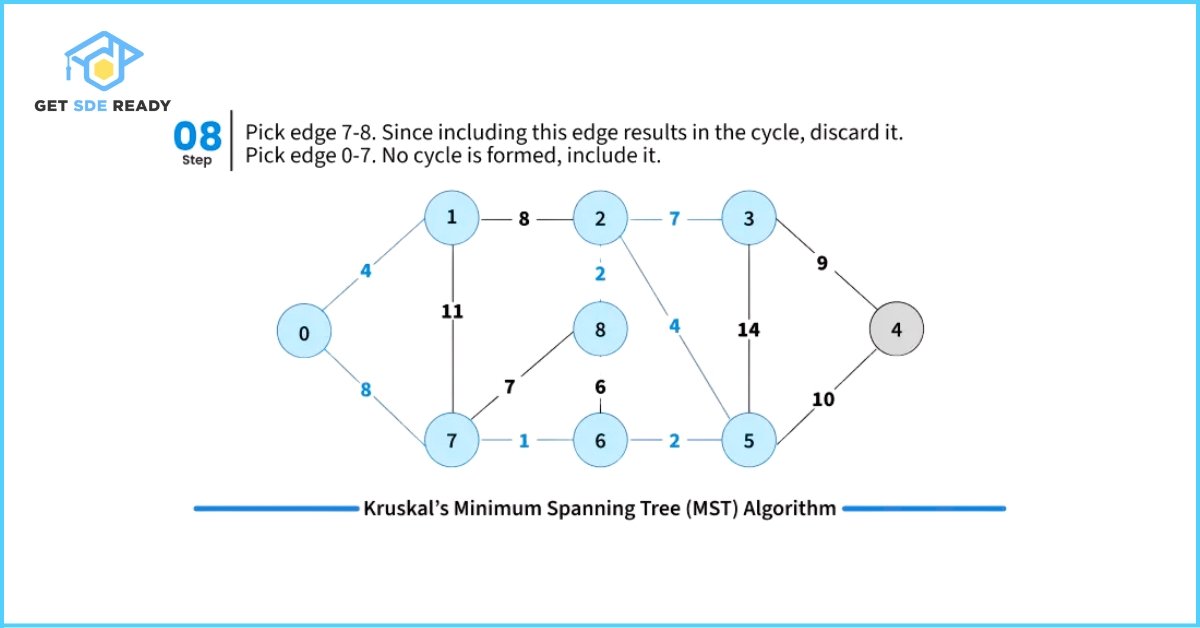
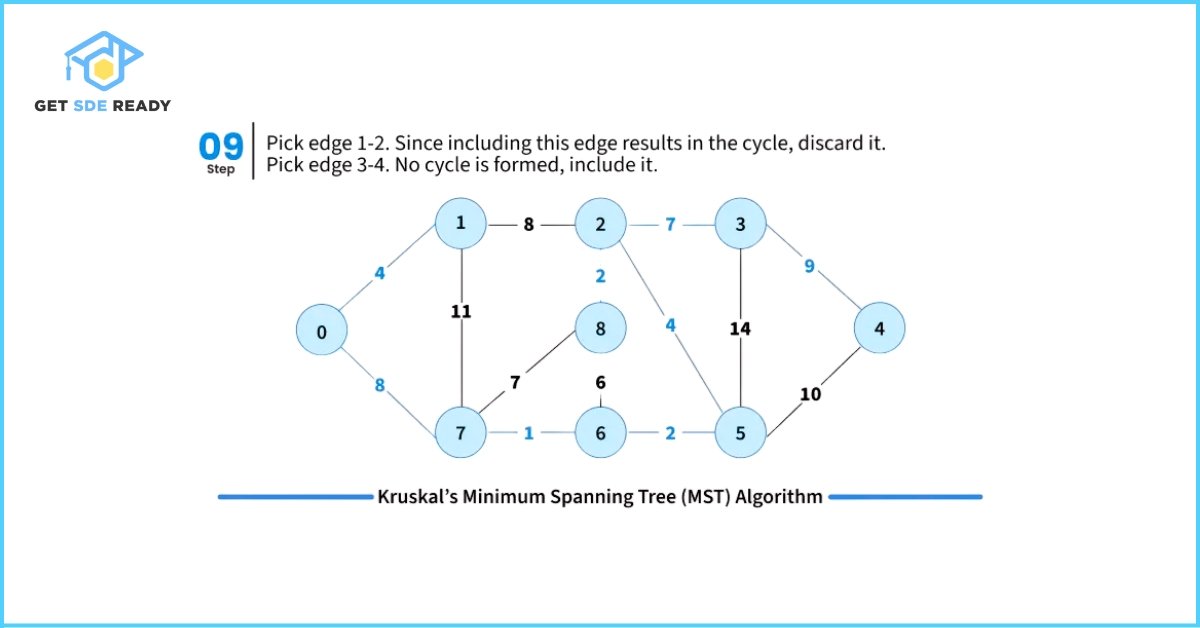
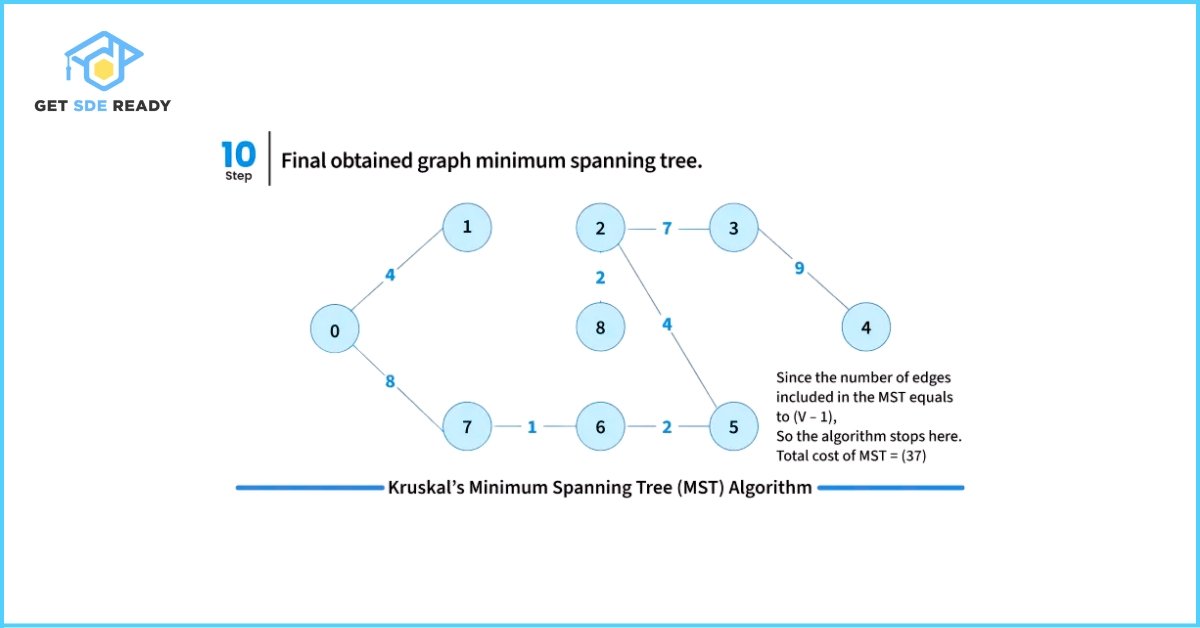
#include <bits/stdc++.h>
using namespace std;
// Disjoint set data struture
class DSU {
vector<int> parent, rank;
public:
DSU(int n) {
parent.resize(n);
rank.resize(n);
for (int i = 0; i < n; i++) {
parent[i] = i;
rank[i] = 1;
}
}
int find(int i) {
return (parent[i] == i) ? i : (parent[i] = find(parent[i]));
}
void unite(int x, int y) {
int s1 = find(x), s2 = find(y);
if (s1 != s2) {
if (rank[s1] < rank[s2]) parent[s1] = s2;
else if (rank[s1] > rank[s2]) parent[s2] = s1;
else parent[s2] = s1, rank[s1]++;
}
}
};
bool comparator(vector<int> &a,vector<int> &b){
if(a[2]<=b[2])return true;
return false;
}
int kruskalsMST(int V, vector<vector<int>> &edges) {
// Sort all edhes
sort(edges.begin(), edges.end(),comparator);
// Traverse edges in sorted order
DSU dsu(V);
int cost = 0, count = 0;
for (auto &e : edges) {
int x = e[0], y = e[1], w = e[2];
// Make sure that there is no cycle
if (dsu.find(x) != dsu.find(y)) {
dsu.unite(x, y);
cost += w;
if (++count == V - 1) break;
}
}
return cost;
}
int main() {
// An edge contains, weight, source and destination
vector<vector<int>> edges = {
{0, 1, 10}, {1, 3, 15}, {2, 3, 4}, {2, 0, 6}, {0, 3, 5}
};
cout<<kruskalsMST(4, edges);
return 0;
}
Searching
Traverse the loop to find a target value, requiring safeguards against infinite loops.
For a quick refresher on these operations, try our crash course.
Implementation of Circular Linked Lists
Let’s see how circular linked lists come to life in code. Below are examples in C, C++, and Java for inserting nodes at the beginning and end.
import java.util.Arrays;
import java.util.Comparator;
class GfG {
public static int kruskalsMST(int V, int[][] edges) {
// Sort all edges based on weight
Arrays.sort(edges, Comparator.comparingInt(e -> e[2]));
// Traverse edges in sorted order
DSU dsu = new DSU(V);
int cost = 0, count = 0;
for (int[] e : edges) {
int x = e[0], y = e[1], w = e[2];
// Make sure that there is no cycle
if (dsu.find(x) != dsu.find(y)) {
dsu.union(x, y);
cost += w;
if (++count == V - 1) break;
}
}
return cost;
}
public static void main(String[] args) {
// An edge contains, weight, source and destination
int[][] edges = {
{0, 1, 10}, {1, 3, 15}, {2, 3, 4}, {2, 0, 6}, {0, 3, 5}
};
System.out.println(kruskalsMST(4, edges));
}
}
// Disjoint set data structure
class DSU {
private int[] parent, rank;
public DSU(int n) {
parent = new int[n];
rank = new int[n];
for (int i = 0; i < n; i++) {
parent[i] = i;
rank[i] = 1;
}
}
public int find(int i) {
if (parent[i] != i) {
parent[i] = find(parent[i]);
}
return parent[i];
}
public void union(int x, int y) {
int s1 = find(x);
int s2 = find(y);
if (s1 != s2) {
if (rank[s1] < rank[s2]) {
parent[s1] = s2;
} else if (rank[s1] > rank[s2]) {
parent[s2] = s1;
} else {
parent[s2] = s1;
rank[s1]++;
}
}
}
}
function kruskalsMST(V, edges) {
// Sort all edges
edges.sort((a, b) => a[2] - b[2]);
// Traverse edges in sorted order
const dsu = new DSU(V);
let cost = 0;
let count = 0;
for (const [x, y, w] of edges) {
// Make sure that there is no cycle
if (dsu.find(x) !== dsu.find(y)) {
dsu.unite(x, y);
cost += w;
if (++count === V - 1) break;
}
}
return cost;
}
// Disjoint set data structure
class DSU {
constructor(n) {
this.parent = Array.from({ length: n }, (_, i) => i);
this.rank = Array(n).fill(1);
}
find(i) {
if (this.parent[i] !== i) {
this.parent[i] = this.find(this.parent[i]);
}
return this.parent[i];
}
unite(x, y) {
const s1 = this.find(x);
const s2 = this.find(y);
if (s1 !== s2) {
if (this.rank[s1] < this.rank[s2]) this.parent[s1] = s2;
else if (this.rank[s1] > this.rank[s2]) this.parent[s2] = s1;
else {
this.parent[s2] = s1;
this.rank[s1]++;
}
}
}
}
const edges = [
[0, 1, 10], [1, 3, 15], [2, 3, 4], [2, 0, 6], [0, 3, 5]
];
console.log(kruskalsMST(4, edges));
from functools import cmp_to_key
def comparator(a,b):
return a[2] - b[2];
def kruskals_mst(V, edges):
# Sort all edges
edges = sorted(edges,key=cmp_to_key(comparator))
# Traverse edges in sorted order
dsu = DSU(V)
cost = 0
count = 0
for x, y, w in edges:
# Make sure that there is no cycle
if dsu.find(x) != dsu.find(y):
dsu.union(x, y)
cost += w
count += 1
if count == V - 1:
break
return cost
# Disjoint set data structure
class DSU:
def __init__(self, n):
self.parent = list(range(n))
self.rank = [1] * n
def find(self, i):
if self.parent[i] != i:
self.parent[i] = self.find(self.parent[i])
return self.parent[i]
def union(self, x, y):
s1 = self.find(x)
s2 = self.find(y)
if s1 != s2:
if self.rank[s1] < self.rank[s2]:
self.parent[s1] = s2
elif self.rank[s1] > self.rank[s2]:
self.parent[s2] = s1
else:
self.parent[s2] = s1
self.rank[s1] += 1
if __name__ == '__main__':
# An edge contains, weight, source and destination
edges = [[0, 1, 10], [1, 3, 15], [2, 3, 4], [2, 0, 6], [0, 3, 5]]
print(kruskals_mst(4, edges))
Output: Shortest Path Distance Matrix
3 0 1 4 6
2 6 0 3 5
3 7 1 0 2
1 5 5 4 0
Each number represents the shortest distance from the row node to the column node after applying the Floyd-Warshall algorithm.
Time Complexity
The algorithm runs in O(V³) time, where V is the number of vertices. This complexity arises from three nested loops, each iterating over all vertices.
Auxiliary Space
The space complexity is O(1) beyond the input distance matrix, as the algorithm updates the matrix in place without requiring additional significant storage.
Note
The above implementation of the Floyd-Warshall algorithm only computes and prints the shortest distances between all pairs of nodes.
If you want to also reconstruct and print the actual shortest paths, the algorithm can be modified by maintaining a predecessor matrix (or parent matrix). This separate 2D matrix stores the predecessor of each node on the shortest path, allowing you to trace back the path from the destination node to the source node.
Real-World Applications of the Floyd-Warshall Algorithm
1. Network Routing in Computer Networking
The Floyd-Warshall algorithm is widely used in computer networks to determine the shortest paths between all pairs of nodes. This helps in efficient routing of data packets, ensuring optimal communication paths in network infrastructure.
2. Flight Connectivity in Aviation
In the aviation industry, this algorithm assists in finding the shortest and most cost-effective routes between airports, optimizing flight paths and connections for passengers and cargo.
3. Geographic Information Systems (GIS)
GIS applications frequently analyze spatial data such as road networks. Floyd-Warshall is used to calculate the shortest paths between various locations, helping in navigation, urban planning, and resource management.
4. Kleene’s Algorithm and Formal Language Theory
A generalization of Floyd-Warshall, known as Kleene’s algorithm, is employed in automata theory to compute regular expressions for regular languages, facilitating pattern matching and compiler design.
Network Routing in Computer Networking
The Floyd-Warshall algorithm is widely used in computer networks to determine the shortest paths between all pairs of nodes. This helps in efficient routing of data packets, ensuring optimal communication paths in network infrastructure.
Flight Connectivity in Aviation
In the aviation industry, this algorithm assists in finding the shortest and most cost-effective routes between airports, optimizing flight paths and connections for passengers and cargo.
Geographic Information Systems (GIS)
GIS applications frequently analyze spatial data such as road networks. Floyd-Warshall is used to calculate the shortest paths between various locations, helping in navigation, urban planning, and resource management.
Kleene’s Algorithm and Formal Language Theory
A generalization of Floyd-Warshall, known as Kleene’s algorithm, is employed in automata theory to compute regular expressions for regular languages, facilitating pattern matching and compiler design.
Output
Below are the edges included in the constructed Minimum Spanning Tree (MST):
Edge: 2 — 3 | Weight: 4
Edge: 0 — 3 | Weight: 5
Edge: 0 — 1 | Weight: 10
Total Weight of the Minimum Spanning Tree: 19
Time and Space Complexity of Kruskal’s Algorithm
Time Complexity
O(E * log E) or O(E * log V)
The most time-consuming step in Kruskal’s Algorithm is sorting all the edges by their weight. If there are E edges, sorting them requires O(E * log E) time.
Once the edges are sorted, the algorithm processes each edge and uses the Disjoint Set Union-Find structure to check for cycles. The find and union operations can be performed in O(log V) time using path compression and union by rank.
Therefore, the total time complexity becomes:
O(E * log E) + O(E * log V) = O(E * log E + E * log V)
Since the number of edges E can be as large as O(V²) in a dense graph, both log V and log E grow similarly. Hence, the time complexity is often simplified to:
O(E * log E) or O(E * log V)
Auxiliary Space Complexity:
O(E + V)
The algorithm requires extra space to store the disjoint set (Union-Find) data structure and the sorted list of edges. As a result, the auxiliary space used is proportional to the number of vertices and edges, i.e., O(V + E).
What is the main difference between Kruskal’s and Prim’s algorithms?
Kruskal’s algorithm is edge-centric, sorting all edges first and picking the smallest one that doesn’t form a cycle; Prim’s is vertex-centric, growing a tree from a starting vertex by adding the smallest edge connecting to the tree. If you prefer structured, step-by-step guidance on spanning tree algorithms, check out our DSA Course for expert-led tutorials.
How does Union-Find (DSU) speed up cycle detection in Kruskal’s Algorithm?
By keeping track of connected components in a tree-like structure. Each find operation locates the root parent of a vertex (compressing paths along the way), and union merges two components by rank. This nearly constant-time check avoids expensive cycle detection via traversal. If you want to see DSU and other algorithmic fundamentals applied in web-based projects, explore our Web Development Course.
Can Kruskal’s Algorithm handle graphs with negative edge weights?
Yes—since Kruskal’s sorts edges by weight, it will include negative-weight edges first (if they don’t create a cycle). The algorithm still produces the MST correctly, even if some edge weights are negative. For comprehensive practice problems on graph algorithms, consider enrolling in our Design DSA Combined program.

DSA, High & Low Level System Designs
- 85+ Live Classes & Recordings
- 24*7 Live Doubt Support
- 400+ DSA Practice Questions
- Comprehensive Notes
- HackerRank Tests & Quizzes
- Topic-wise Quizzes
- Case Studies
- Access to Global Peer Community
Buy for 60% OFF
₹25,000.00 ₹9,999.00
Accelerate your Path to a Product based Career
Boost your career or get hired at top product-based companies by joining our expertly crafted courses. Gain practical skills and real-world knowledge to help you succeed.

Low & High Level System Design
- 20+ Live Classes & Recordings
- 24*7 Live Doubt Support
- Case Studies
- Comprehensive Notes
- HackerRank Tests
- Topic-wise Quizzes
- Access to Global Peer Community
- Interview Prep Material
Buy for 65% OFF
₹20,000.00 ₹6,999.00

Fast-Track to Full Spectrum Software Engineering
- 120+ Live Classes & Recordings
- 24*7 Live Doubt Support
- 400+ DSA Practice Questions
- Comprehensive Notes
- HackerRank Tests & Quizzes
- 12+ live Projects & Deployments
- Case Studies
- Access to Global Peer Community
Buy for 57% OFF
₹35,000.00 ₹14,999.00

DSA, High & Low Level System Designs
- 85+ Live Classes & Recordings
- 24*7 Live Doubt Support
- 400+ DSA Practice Questions
- Comprehensive Notes
- HackerRank Tests & Quizzes
- Topic-wise Quizzes
- Case Studies
- Access to Global Peer Community
Buy for 60% OFF
₹25,000.00 ₹9,999.00

Design Patterns Bootcamp
- Live Classes & Recordings
- 24/7 Live Doubt Support
- Practice Questions
- Case Studies
- Access to Global Peer Community
- Topic wise Quizzes
- Referrals
- Certificate of Completion
Buy for 50% OFF
₹2,000.00 ₹999.00

LLD Bootcamp
- 7+ Live Classes & Recordings
- Practice Questions
- 24/7 Live Doubt Support
- Case Studies
- Topic wise Quizzes
- Access to Global Peer Community
- Certificate of Completion
- Referrals
Buy for 50% OFF
₹2,000.00 ₹999.00

Essentials of Machine Learning and Artificial Intelligence
- 65+ Live Classes & Recordings
- 24*7 Live Doubt Support
- 22+ Hands-on Live Projects & Deployments
- Comprehensive Notes
- Topic-wise Quizzes
- Case Studies
- Access to Global Peer Community
- Interview Prep Material
Buy for 65% OFF
₹20,000.00 ₹6,999.00
Reach Out Now
If you have any queries, please fill out this form. We will surely reach out to you.
Contact Email
Reach us at the following email address.
arun@getsdeready.com
Phone Number
You can reach us by phone as well.
+91-97737 28034
Our Location
Rohini, Sector-3, Delhi-110085